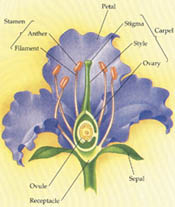
:: chronology of significant events in gametophytic self-incompatibility research1. overview of plant development and fertilization a. plant life cycle b. the process of gametogenesis c. pollen tube growth and fertilization 2. prevention of self-pollination a. necessity of maintaining genetic variance b. types of blocks to inbreeding c. sporophytic v. gametophytic self-incompatibility 3. primary points of research a. the two fundamental questions regarding SI b. the tripartite model => three-pronged approach c. search for products of S-alleles 4. Lee et al. S protein connected to GSI a. knock out experiments with transgenic plants b. gain of function experiments c. Murfett and others provide additional evidence 5. S proteins are RNases a. amino acid sequence similarity to fungal RNases b. two models of S-RNase function c. conservation of important histidines 6. the pollen-part a. failed attempts at finding a pollen-part homologue b. attempts to characterize the pollen-part 7. Sassa et al. pollen-part is independent of S protein a. Japanese pear mutant Osa-Nijisseiki b. Northern blot analysis indicates major deletion of S4 c. PCR picks up some full S4 fragments 8. Challenges to the cytotoxic model of pollen tube arrest a. some general Q's about cause and effect b. Lush and Clark 9. Walles and Han: not a general degradation of r and mRNA a. detection of ribosomes with electron microscopy b. no general decrease in ribosomes on ER 10. Future research and practical applications a. find the pollen-part b. settle the issue of the RNase function c. use technology to aid in hybrid seed production d. use technology for fruit production
:: list of references